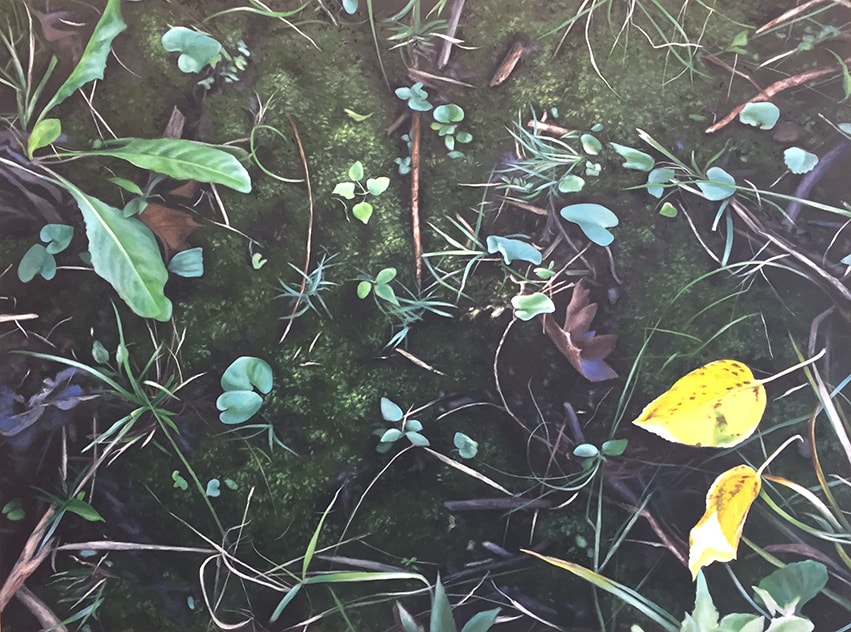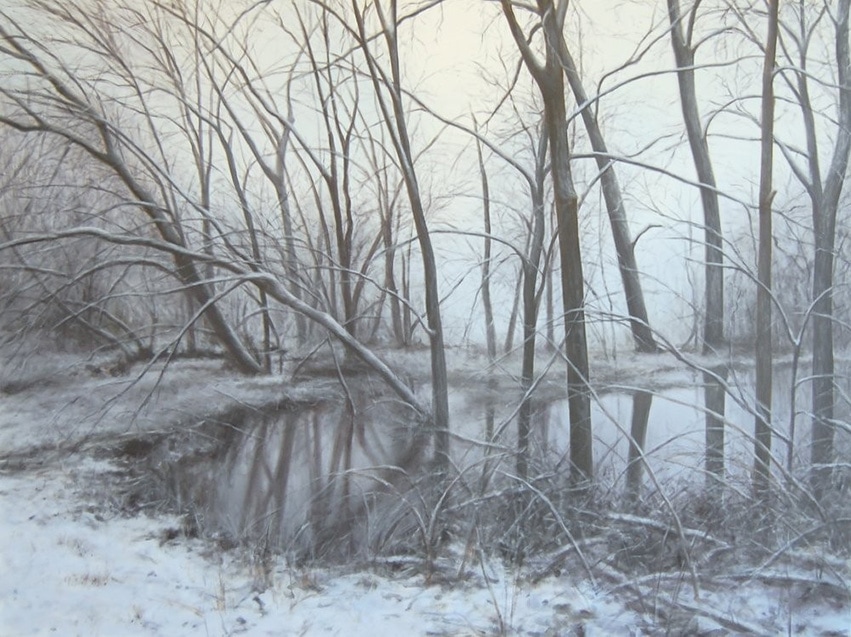We see it every day, yet rarely pause to appreciate it. Spring’s pastels, the pervasive greens of summer, warm hues of amber in autumn, and the crisp, blue chill of winter… To the patient observer, each season in the Midwest brings new things to see and discover. As the famous naturalist and conservationist John Muir once said, “In every walk with nature, one receives far more than he seeks.”
Peoria-based artist Ann E. Coulter has patiently and painstakingly carved out time to tell the stories of the Midwestern landscape. Within her paintings, one finds exactly what Muir was alluding to: a journey filled with unexpected treasures.
Prairie Roots
A native of Joliet, Illinois, Coulter has been drawing the world around her since childhood. “I had an innate hand-eye coordination, so I could draw what I saw from a really early age,” she explains. She grew up with parents who loved nature, and spent lots of time outdoors with her family. But after completing her bachelor’s degree at Illinois State University, she was ready for a change of scenery.
“I lived in Illinois my whole life… and I was eager to go somewhere else. I don’t think I really appreciated what was here,” she observes. Even prior to painting landscapes, she had an instinctive sense of the significance of her surroundings. “It was really important for me, not so much what school I went to as what place I went to,” Coulter reflects.
She enrolled in a master’s degree program in San Diego, which afforded her the fresh perspective she needed. “I didn’t really understand that my work needed to be nature-based until I was living in an urban environment—and missing all the things that I had grown up with here, like the change of seasons and the verdant greens.” Upon graduation, she returned to Illinois.

For decades Coulter was known for her work with pastels. “I was a painter and kind of abandoned it in graduate school because I was just so in love with paper,” she recalls. In recent years, however, she began to feel constricted by the medium, so she returned to oils. “I put all my pastels away and just said, I’m going to paint for a while.”
Her landscape paintings, like her pastels, present a challenge: there are an infinite number of stories to tell. In addition, because we see landscapes every day, Coulter must grapple with an audience’s expectations. “Landscape is tricky in that way, because we think we know it and we’ve all seen lots of landscape paintings. We know what a sunset looks like,” she offers. “So how, as an artist, do you trigger somebody’s response?”
Coulter spends countless hours trying to capture fleeting moments of beauty—not only analyzing what she observes in nature, but attempting to understand the human reaction to it. “It’s so fascinating that we can have different responses, but we also have universal responses,” she muses. “A sunny day makes you feel better, you’re happier… And then when it’s dark and gray and gloomy, it’s kind of depressing. It’s a pretty universal response.
“What is that? Where did it come from, and how much of it is hereditary and how much is environment? I just find that really interesting.”
Translating the Land
Her consideration of these questions drives the kinds of landscapes she paints (for instance, people tend to prefer summer landscapes), and even influences her creative process. When you picture a landscape artist, you might envision someone in a field, standing in front of an easel as they paint—or plein air (“outside”) painting. But that does not feel natural to Coulter. “I’m sort of slow to assimilate what I see and what’s around me,” she suggests. “I’d much rather experience what I’m seeing just by being in it and trying to take it all in at the time.”
Instead, she takes photographs—dozens and dozens of photographs. “I edit them, I crop them—they’re sort of my first opportunity for translation,” she explains. They act as pieces of a puzzle: within a pile of 50 photographs of the same subject, she’ll find the smallest of variations. Sometimes that is due to the sunlight; other times it’s a slight shift in the camera angle. This is in part why her work is so mesmerizing.
Rather than painting from a single photograph, she uses multiple images to help reconstruct a memory—to tell a story. “I like to think about how that translates into our lives, and how everybody has their own truths, fictions and versions,” she notes. It allows her work to make forward movements, rather than reflecting a static perspective. Her edits give voice to the smallest of details—the way light hits a pebble, or the patterns she notices in a tree’s branches.

“I’m really interested in how it’s all put together,” she adds. “If you make one little change, everything shifts. I like that puzzling of it—dissecting and deciphering and putting it back together. I like seeing it in that intense way.”
That Coulter manages to communicate all of this in painting the Midwestern landscape is no small feat. Artists who grew up in the European landscape tradition, she notes, struggled to communicate what they were seeing when they first arrived in America hundreds of years ago. “They didn’t know how to deal with it,” she explains. “It was flat… They thought it was a desert wasteland.”
Today, people tend to view the Midwestern landscape in a utilitarian way. But as Coulter points out, the utility of the farmland and the river is the very reason we are here. “I just think that people sometimes haven’t taken the time or the interest to look for the beautiful side of it,” she suggests. “It’s a very subtle beauty here—and I think that is valid. It’s just as beautiful as anywhere in the world. It’s just not the same vocabulary.”
Coulter excels at uncovering these subtle forms of beauty. She even prefers to paint landscapes that are not exceptionally bright, but reflect a more natural light. “What is intriguing to me are those times after the sunset, but before it is dark,” she explains. “I really like those overcast days and what that does to the light.
“I find it a lot harder to say something about a bright, sunny, green and blue day,” she laughs. “I don’t know why.”
In her most recent paintings, Coulter has been zooming in on small patches of earth, as if looking straight down at the ground—a patchwork of twigs, leaves, grass and the like. “It sort of flattens the space. It becomes more object-oriented, rather than depth-oriented,” she notes. These paintings are heavy in pattern and rhythm, leaving viewers with the sensation of having walked through ancient woods.
Coulter’s paintings are intimate, which she says is a deliberate choice. “I want to feel like I’m in it—that I’m touching it and smelling it. It’s right here in front of me, and it’s complex, and I can’t see it all,” she says. “In order to focus on those kinds of things, oftentimes I give up that sense of deep space. It has taken me some time to embrace that.”

Moments of Pause
Artist Bill Conger, curator of collections and exhibitions at the Peoria Riverfront Museum, is a longtime friend of Coulter’s. Reflecting on her work, he remarks that he finds time and place are suspended. “Her ability to access an empathic understanding of what landscape means, rather than looks like, has realized some of the most mysterious and evocative interpretations of the land that surrounds us,” he asserts. “The almost meditative quality of her work draws us near, slows us down and demands consideration—a fascinating quality within the landscape tradition.”
Local arts expert John Heintzman calls Coulter the “consummate landscape artist,” offering additional praise for her work. “Her interpretation of any landscape,” he notes affectionately, “takes each of us to a place that always provides comfort and security, and reminds us of the true beauty of nature.”
While Coulter has no upcoming exhibitions locally, she finds that these moments of pause allow her the time she needs to create. Over the past year, she’s worked on a lot of smaller pieces. “I’m not very good at working small,” she says with a smile. “But now I’m feeling the need to go big. I think before too long, I’ll probably stretch a big canvas and do something as big as I can comfortably make it.”
In the meantime, don’t be surprised to find Ann E. Coulter outdoors, quietly observing and hunting for inspiration. “I like the idea of just trying to really see what’s there. Discover that—and try to say something about it,” she states serenely. “That says, This is enough. This is what’s here—and it’s really beautiful. And there’s a lot to be learned from it.” PM
For more information, visit annecoulterartist.com.




